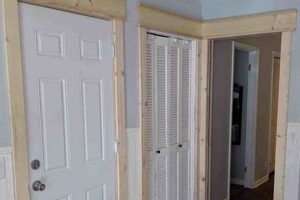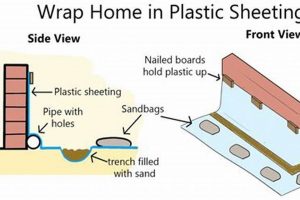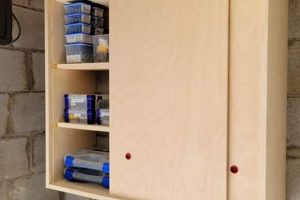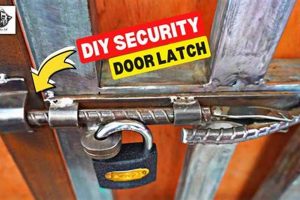Creating a bypass or pocket entry system using readily available materials and instructions represents a practical approach to home improvement. This methodology encompasses projects ranging from assembling pre-fabricated kits to constructing a complete door and track mechanism from raw components. An example includes adapting an existing hinged door for sliding functionality to maximize space utilization in confined areas.
Implementing such projects offers advantages, including cost savings compared to professional installation, increased flexibility in design choices, and the satisfaction of completing a hands-on project. Historically, homeowners have embraced this type of undertaking to personalize living spaces and adapt homes to evolving needs, driven by resourcefulness and a desire to enhance property value.
The subsequent sections will address essential aspects of successfully executing this type of project, covering topics such as material selection, hardware considerations, installation techniques, and potential challenges encountered during the process. These details are crucial for achieving a functional and aesthetically pleasing result.
Tips for Sliding Door DIY Projects
Successful execution hinges on careful planning and precise implementation. The following tips are designed to mitigate potential challenges and maximize the likelihood of achieving a satisfactory outcome.
Tip 1: Precise Measurement is Paramount. Accurate dimensions of the opening are essential for selecting appropriately sized doors and hardware. Account for track placement and any necessary clearances.
Tip 2: Prioritize High-Quality Hardware. Investing in durable tracks, rollers, and handles ensures smooth operation and longevity. Inferior components can lead to premature failure and functional impairment.
Tip 3: Select Appropriate Door Material. The choice of material solid wood, hollow-core, or glass influences weight, stability, and acoustic properties. Consider the intended use and environmental conditions when making this selection.
Tip 4: Ensure Structural Integrity. Verify that the wall or frame supporting the track is structurally sound. Reinforce as needed to prevent sagging or detachment over time.
Tip 5: Implement a Soft-Close Mechanism. This feature prevents slamming and reduces wear on the door and hardware. It enhances safety and user experience.
Tip 6: Apply a Durable Finish. Protect the door surface with a suitable paint, stain, or sealant to resist moisture, scratches, and UV damage. Proper finishing extends the lifespan and maintains aesthetic appeal.
Tip 7: Test and Adjust Thoroughly. After installation, meticulously test the door’s operation and make any necessary adjustments to ensure smooth and consistent movement. Address any binding or rubbing immediately.
Adherence to these guidelines contributes significantly to the successful completion of a sliding door project, yielding a functional and aesthetically pleasing addition to any space.
The subsequent section will address common pitfalls and troubleshooting strategies to further enhance the likelihood of a successful installation.
1. Hardware Selection
The selection of appropriate hardware is intrinsically linked to the success of sliding door projects. Functionality and longevity are directly determined by the quality and suitability of the chosen components. Inferior rollers, tracks, or handles can result in operational failures, compromised safety, and diminished aesthetic appeal. For example, a heavy solid-core door installed with inadequate rollers will exhibit difficulty in operation and potentially cause premature wear on the tracking system. The inverse is equally true; lightweight hollow-core doors are often suitable for basic hardware.
Considerations extend beyond basic functionality to encompass features such as soft-close mechanisms, which reduce wear and prevent slamming. Track design also influences performance. Top-hung systems, where the door is suspended from a track above, require robust support structures. Bottom-rolling systems, conversely, distribute weight more evenly but require smooth and level floor surfaces. The selection of these systems depends on wall construction and the structural integrity of the surrounding framework. Real-world applications demonstrate that prioritizing high-quality hardware translates to long-term reliability, whereas economizing on hardware often leads to costly repairs or complete system replacement.
In summary, the careful selection of hardware is not merely a supplementary step but a critical determinant of overall project success. Addressing specific requirements concerning door weight, structural support, and desired features leads to a stable and efficient sliding system. The interplay between door type, track design, and hardware quality underpins functional longevity, aesthetics, and user satisfaction. Therefore, hardware selection requires meticulous evaluation of project-specific demands.
2. Door Material
The choice of door material in a sliding door project directly impacts functionality, aesthetics, and structural requirements. This decision is not merely cosmetic; it determines the hardware demands, ease of installation, and long-term durability.
- Weight and Hardware Compatibility
Solid-core wood doors, for example, possess substantial weight, necessitating robust tracks and rollers capable of supporting the load without compromising smooth operation. Conversely, lightweight hollow-core doors require less heavy-duty hardware, potentially reducing project costs. Glass doors introduce a unique set of considerations related to weight distribution and the selection of appropriate glazing and framing systems.
- Installation Complexity and Skill Level
Working with solid wood often demands advanced woodworking skills for precise cutting, shaping, and finishing. Materials like MDF (Medium-Density Fiberboard) offer easier workability but may require careful sealing to prevent moisture damage. The DIYer’s skill level and available tools should align with the material’s demands.
- Aesthetic Integration and Design Considerations
The material must complement the surrounding architectural style and interior design. Reclaimed wood offers rustic charm, while sleek glass panels create a modern aesthetic. The choice also impacts the finishing options available, from paint and stain to specialized coatings for enhanced durability.
- Cost and Budgetary Constraints
The cost of door materials varies widely. Solid wood represents a significant investment, while alternatives like hollow-core or MDF can offer more budget-friendly solutions. The final material selection must balance desired aesthetic qualities with budgetary limitations.
In summary, door material selection represents a foundational decision point in a sliding door project. The interdependencies among material properties, installation requirements, aesthetic goals, and budgetary constraints ultimately determine the success and longevity of the installation. The characteristics inherent in different materials necessitate a strategic approach to maximize benefits while mitigating potential challenges.
3. Track Installation
Track installation constitutes a critical phase in any sliding door project, directly influencing operational efficiency, safety, and overall system longevity. Improper installation can negate the benefits of high-quality doors and hardware, resulting in functional impairment and potential safety hazards.
- Alignment and Leveling
Precise alignment and leveling are paramount for smooth door movement and preventing premature wear on rollers and tracks. Deviations from horizontal or vertical planes create friction and binding, impeding operation. For instance, even a slight misalignment in a top-hung system can place undue stress on the supporting structure, leading to eventual failure.
- Secure Mounting and Load Distribution
The track must be securely mounted to a structurally sound surface capable of supporting the door’s weight. Insufficient anchoring or inadequate reinforcement can lead to sagging or detachment, particularly with heavier solid-core doors. Proper load distribution is essential for preventing localized stress points that compromise the integrity of the installation.
- Hardware Compatibility and Functionality
The selected track must be compatible with the chosen rollers and other hardware components. Incompatible components can create operational inefficiencies or lead to premature wear. For example, using rollers designed for a V-groove track on a flat track surface will result in inconsistent and noisy operation.
- Clearance and Accessibility
Adequate clearance around the track is necessary to allow the door to operate freely without obstruction. Consider potential obstructions such as trim, molding, or adjacent walls. Accessibility for maintenance and adjustments should also be factored into the installation plan. Limited accessibility complicates future repairs or modifications.
These facets of track installation underscore its significance within the broader context of implementing such projects. Successful execution requires meticulous attention to detail, adherence to manufacturer specifications, and an understanding of structural principles. Failure to address these elements can compromise the entire system, undermining the intended benefits and potentially creating safety risks. The convergence of precise alignment, secure mounting, hardware compatibility, and operational clearance underpins a functional and durable sliding door installation.
4. Space Constraints
Space constraints represent a primary motivator for undertaking sliding door installations. The capacity to maximize usable area, particularly in compact living environments, underscores the utility of sliding mechanisms over traditional hinged doors.
- Door Swing Elimination
Conventional hinged doors require a designated swing radius, which can impede traffic flow and limit furniture placement in confined spaces. Sliding doors eliminate this requirement, allowing for more efficient spatial utilization. An example is a small bathroom where a hinged door would obstruct access to fixtures, making a sliding pocket door a more practical solution.
- Pocket Door Integration
Pocket doors, which slide into a recess within the wall, offer a complete elimination of the door’s presence when open. This design is particularly beneficial in situations where every inch of space is valuable, such as small apartments or narrow hallways. Installing a pocket door maximizes wall space for storage or decor.
- Bypass Door Configuration
Bypass doors consist of two or more panels that slide horizontally past each other. While not as space-efficient as pocket doors, they offer a compromise by reducing the required swing radius. This configuration is suitable for closets or room dividers where complete wall access is not a priority.
- Track System Considerations
The type of track system employed impacts the overall space efficiency. Top-hung systems, which suspend the door from above, eliminate the need for a floor track, creating a cleaner, more seamless transition between spaces. Conversely, bottom-rolling systems may require a floor track, which can be a tripping hazard or impede wheelchair accessibility.
The integration of sliding doors addresses spatial limitations, offering viable solutions where conventional hinged doors prove impractical. The selection of door style and track system dictates the degree of space optimization achieved, demonstrating the inherent connection between spatial constraints and the adoption of sliding door strategies.
5. DIY Skill Level
The aptitude and experience of the individual undertaking a sliding door installation significantly influence the project’s outcome. Success hinges on matching the complexity of the installation to the homeowner’s capabilities. An accurate self-assessment of skills is paramount.
- Measurement and Precision
Accurate measurement constitutes a foundational skill. Sliding door installations demand precision in dimensional calculations and execution. Inaccurate measurements can lead to misalignment, operational issues, and aesthetic deficiencies. Those lacking experience in precise measurement may encounter difficulties in properly fitting doors and hardware within the designated opening.
- Carpentry and Construction Knowledge
A fundamental understanding of carpentry principles is often necessary. Modifying door frames, reinforcing structural supports, and installing hardware require a grasp of basic construction techniques. Individuals without prior carpentry experience may struggle with these aspects, potentially compromising the structural integrity of the installation.
- Tool Proficiency and Safety
The safe and effective use of power tools is essential. Sliding door installations typically involve tasks such as cutting, drilling, and fastening. Inexperience with power tools increases the risk of injury and damage to materials. Proficiency in using tools such as saws, drills, and levels is crucial for achieving accurate and safe results.
- Problem-Solving and Adaptability
Unexpected challenges often arise during DIY projects. The ability to troubleshoot problems and adapt to unforeseen circumstances is valuable. Sliding door installations can present unique obstacles, such as non-standard openings or hidden structural elements. Individuals with strong problem-solving skills are better equipped to overcome these challenges and achieve a successful outcome.
In summary, the correlation between the installer’s skill level and the success of a sliding door project is undeniable. Realistic self-assessment and adequate preparation are critical factors in determining whether a DIY approach is feasible. Failure to account for skill limitations can result in compromised functionality, aesthetic shortcomings, and potential safety hazards.
6. Budget Adherence
Maintaining budgetary control is a critical aspect of undertaking such home improvement projects. Financial constraints often dictate the scope and quality of materials employed, directly impacting the project’s feasibility and long-term performance. Careful planning and cost management are therefore essential for achieving a successful outcome without exceeding allocated resources.
- Material Selection Trade-offs
Budgetary limitations frequently necessitate compromises in material selection. Lower-cost alternatives, such as hollow-core doors or less expensive track systems, may be chosen over higher-quality options like solid-core doors or premium hardware. These trade-offs directly affect durability, aesthetics, and operational longevity, requiring careful consideration of potential long-term costs associated with reduced quality.
- Hardware Cost Variations
The cost of hardware components, including rollers, tracks, and handles, varies significantly. Budget-conscious installations may opt for basic hardware, while more expensive options offer enhanced features such as soft-close mechanisms or improved weight capacity. The selection of hardware directly influences the door’s functionality and lifespan, underscoring the need to balance cost considerations with performance requirements.
- Installation Complexity and Labor Costs
Complex installations, such as those involving pocket doors or custom-sized openings, can increase labor costs. Homeowners may choose to undertake a portion of the work themselves to reduce expenses, but this requires a realistic assessment of their skills and available time. Balancing DIY efforts with professional assistance is essential for controlling costs while ensuring a satisfactory outcome.
- Unexpected Expenses and Contingency Planning
Unforeseen issues, such as structural repairs or modifications to existing frameworks, can arise during installation, adding unexpected expenses to the project. Contingency planning, including setting aside a portion of the budget for unforeseen costs, is prudent. Failure to account for potential setbacks can lead to budget overruns and project delays.
Effective management of financial resources is pivotal for realizing the goals of such projects. By carefully evaluating material options, hardware selections, installation strategies, and potential contingencies, homeowners can maximize value while adhering to budgetary limitations. Success is defined by the balance between financial prudence and the achievement of functional and aesthetic objectives.
7. Safety Precautions
Undertaking sliding door installation necessitates rigorous adherence to safety protocols. A failure to prioritize safety can result in physical injury, property damage, and project delays. The correlation between safety precautions and successful implementation is direct and consequential; negligence in one area invariably compromises the other. For instance, neglecting to wear safety glasses while cutting materials can lead to eye injuries, while improper lifting techniques can cause back strain. Such incidents not only impede project progress but also expose individuals to unnecessary harm.
The integration of safety measures into all stages of the installation process mitigates risks. This includes wearing appropriate personal protective equipment (PPE), ensuring a clean and organized work area, and utilizing tools according to manufacturer guidelines. Furthermore, understanding the structural integrity of the surrounding framework is critical for preventing collapses or instability during installation. Real-world instances of improperly supported track systems demonstrate the potential for severe consequences, ranging from property damage to personal injury. A methodical approach, incorporating safety checks at each step, ensures a secure and stable final product.
In summary, safety precautions are not supplementary but integral to a successful sliding door undertaking. The relationship is causal: adherence to safety protocols reduces the likelihood of accidents and injuries. Integrating safety as a primary consideration from planning to execution enhances the prospect of a successful, risk-minimized project. Neglecting this facet increases the probability of adverse events, undermining both the project’s objectives and the well-being of those involved.
Frequently Asked Questions
The following questions address common concerns regarding implementing sliding door projects. The answers provided aim to clarify potential ambiguities and offer practical guidance.
Question 1: Is specialized expertise required for implementing such projects?
While prior experience in carpentry or home improvement is beneficial, it is not strictly mandatory. A thorough understanding of basic construction principles, coupled with meticulous attention to detail and adherence to instructions, suffices for less complex installations. More intricate projects, such as those involving pocket doors or custom framing, may necessitate professional assistance.
Question 2: What tools are essential for successfully installing a sliding door?
Essential tools include a measuring tape, level, stud finder, drill with various bits, screwdriver (both manual and power), saw (circular or hand saw), safety glasses, and work gloves. Additional tools, such as a router or planer, may be required depending on the complexity of the installation and the materials involved.
Question 3: How does one accurately measure the opening for a sliding door?
Precise measurements are critical. Measure the width and height of the opening at multiple points to account for any irregularities. Ensure the measurements are taken after removing any existing trim or molding. Subtract the manufacturer’s recommended clearances to determine the appropriate door size.
Question 4: What are the primary considerations when selecting hardware for a sliding door?
The weight and material of the door are paramount considerations. Heavier doors require more robust rollers and tracks. Ensure the hardware is compatible with the door’s thickness and the track system employed. The presence of features such as soft-close mechanisms or anti-jump devices should also be evaluated.
Question 5: How can one ensure the track is properly aligned and level during installation?
Utilize a level to verify that the track is horizontally and vertically aligned. Employ shims as needed to compensate for any unevenness in the wall or floor. Secure the track to studs or solid backing to ensure stability and prevent sagging.
Question 6: What are common pitfalls to avoid during a sliding door installation?
Common pitfalls include inaccurate measurements, improper hardware selection, inadequate structural support, and failure to follow manufacturer instructions. Neglecting to account for these potential issues can lead to operational problems, safety hazards, and aesthetic deficiencies.
Adhering to the above principles can minimize challenges and maximize the likelihood of a satisfactory outcome.
The subsequent section delves into troubleshooting strategies for addressing common issues encountered during the installation process.
Conclusion
This exploration of sliding door diy has underscored the multifaceted nature of such projects. Successfully integrating such a project requires careful consideration of space constraints, DIY skill level, and budgetary limitations, coupled with an unwavering commitment to safety precautions. The selection of appropriate materials, hardware components, and installation techniques directly influences the functionality, longevity, and aesthetic appeal of the final result.
The effectiveness of sliding door diy strategies depends on a balanced approach, acknowledging the interdependencies among all critical elements. The decision to undertake such a project should be informed by a realistic assessment of capabilities and resources, ensuring the realization of both practical and aesthetic objectives. The long-term benefits gained from this type of project are best achieved through meticulous planning and diligent execution.







